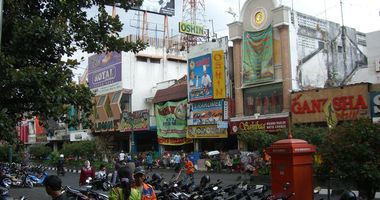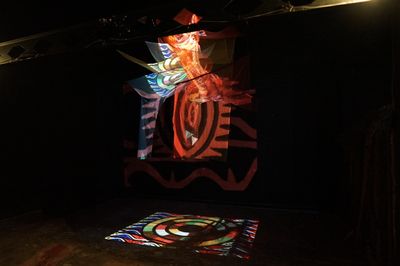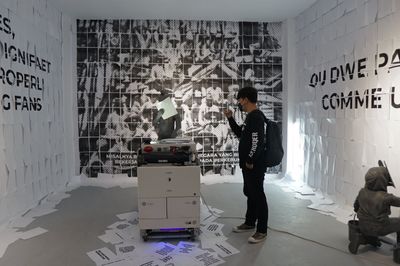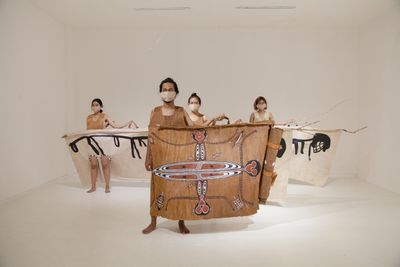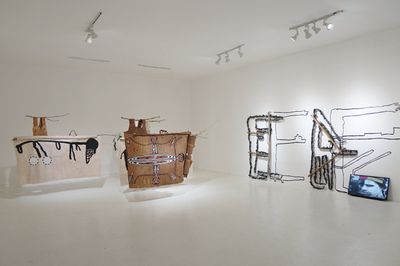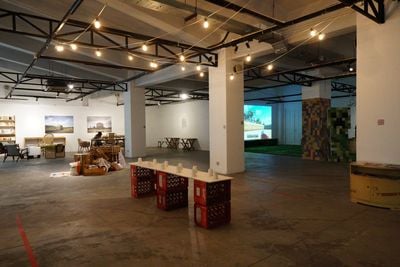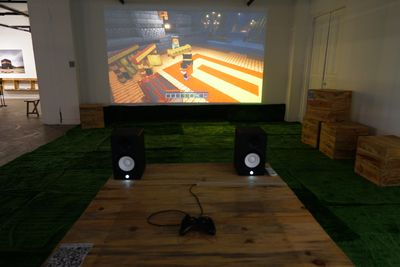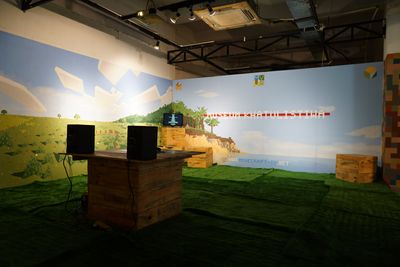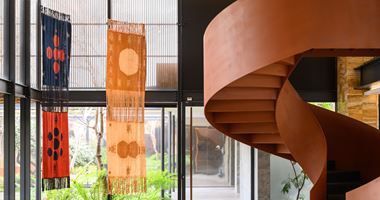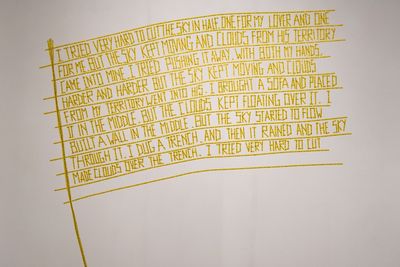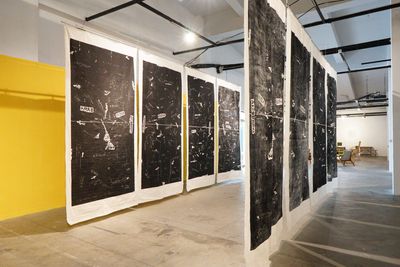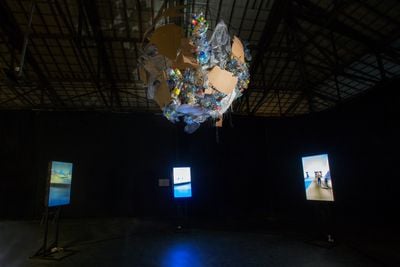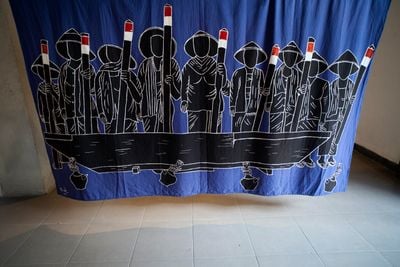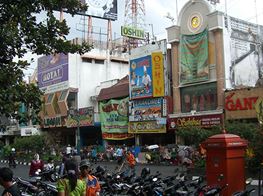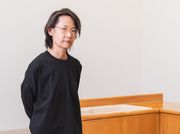At Biennale Jogja XVI, Narratives and Counter-Narratives Unite
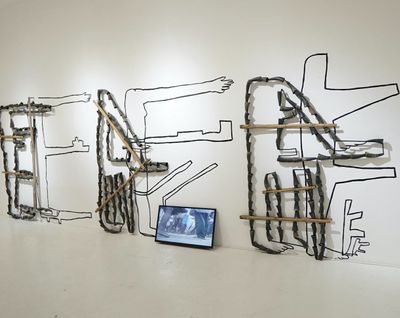
Mella Jaarsma and Agus Ongge, At First There's Black (2021). Exhibition view: Biennale Jogja XVI – Equator #6 2021 – Indonesia with Oceania, Jogja National Museum, Yogyakarta (6 October–14 November 2021). Courtesy Biennale Jogja Foundation.
A striking mural by Yanto Gombo of Udeido Collective marks the main entrance to the Jogja National Museum, the main venue of Biennale Jogja XVI – Equator #6 2021 – Indonesia with Oceania (6 October–14 November 2021) in Yogyakarta.
Titled Dibungkam (Silenced, 2021), the painting's muted green and brown tones are reminiscent of military camouflage. At the focal point is the face of a man from the Dani tribe, surrounded by fragments depicting violence, repression, discrimination, and racism against the marginalised proto-Papuan.
Works by other members of the Udeido Collective can be found in the first room of the three-story building: a series of mixed-media installations titled Koreri Projection (2021) that portray journeys of the Papuan to koreri, the Indigenous Byak term of the promised land.
Udeido Collective, whose members are spread across cities in Papua, was established in 2018 to encourage younger generations of artists to explore folklores and social issues experienced by the Papuan. The name Udeido comes from the word 'ude', which refers to a type of leaf commonly used by the Indigenous Mee to heal wounds.
The collective itself can be perceived as a healing space for intergenerational trauma, free from fear, oppression, and discrimination, which is still very much a part of Papuan daily reality.
For Papuan artists to present artwork about the Papuan struggle in Java is comparable to presenting it in the belly of the beast.
In West Papua, the easternmost and most problematic region in Indonesia, attempts at development and modernisation are entangled with human rights violations and ongoing conflicts. For Papuan artists to present artwork about the Papuan struggle in Java is comparable to presenting it in the belly of the beast.
A more blatant example of violence endured on Papuan land is presented, rather poetically, in the audiovisual installation Di Tanah Orang Papua (On the Papuan Land, 2021): a collaborative work developed as part of the Biennale's artist-in-residence programme, between young Jogja-based artist Arief Budiman, activist and filmmaker Harun Rumbarar of Papuan Voices, and musician Max Binun of the Black Paradise group.
Footage portraying military violence clashes with the sounds of Papuan folk song 'Nyanyian Sunyi' ('Silent Song'), an anthem of Papuan resistance written by Sam Kapisa and deliberately sung in Indonesian.
Another collaborative work by Mella Jaarsma and Agus Ongge titled At First There's Black (2021) sheds light on forms of repression under the pretext of modernity that have eliminated local traditions, including the use of bark to create clothes.
Agus Ongge initiated a reclamation of such knowledge by applying painted motifs onto bark-made cloth, including endangered fish from Lake Sentani.
An online conversation between Ongge and Jaarsma about the urgency to reclaim disappearing knowledge and the tension between contemporary art and tradition is captured in a single-channel video.
At one point, Ongge brings up the colour red. 'In Java', Ongge notes, 'the colour red means brave, but here [in Papua], if you see the colour red on the street, by the tree, or in other places, it means blood has been shed and life was lost.'
The intersection of narratives and counter-narratives pulses through Biennale Jogja XVI, which presents work by 27 artists and 9 collectives: stories that draw connections across Oceania, highlighting Indonesia's relation to it.
Co-curated by artist Elia Nurvista and young curator Ayos Purwoaji, the Biennale's title Roots < > Routes dynamically encompasses different issues at once: the tension between culture and mobility; indigeneity and racialism; borders and diaspora; myth and modernity; situated knowledge and ecological crisis; the ideology of development and the limits of growth; traces of language and cultural assimilation; not to mention contemporary socio-politics.
The result is a clamorous show that carries ideas of decentralisation as praxis, exemplified in Radio Isolasido (2021), an on-site sound installation, FM radio network, and online radio station.
Initiated by Woto Wibowo (Wok The Rock)—an artist and curator who works across contemporary art, design, and music—and developed with music composer and sound engineer Gatot Danar Sulistiyanto, Radio Isolasido unravels narrative and non-narrative acoustic phenomena.
Among the radio's transmissions are cooking tutorials from Lembata, East Nusa Tenggara and Tidore, Maluku; popular poetry read in Indonesian LGBTQI+ slang; and sounds of extinct and endangered birds, such as the Cratoavis cearensis and the Kalimantan rangkong.
While Biennale Jogja XVI starts with a dialogue about common socio-political conditions within eastern Indonesia, its purpose is to bridge social imaginations and give birth to new transformative languages in the process
Although operating on a limited budget and prepared during the catastrophic second wave of the pandemic in Indonesia, the Biennale's Equator series—a project that focuses on art and artists of equatorial regions—has developed an ambitious and expansive programme under the directorship of Gintani Nur Apresia Swastika, with forums, panel discussions, and performances, screenings, workshops, and curatorial tours.
Commenced in 2011 by the Biennale Jogja Foundation to challenge the dominance of the concept of the 'centre' in the international art scene, Equator has focused on a specific country or region for the last six Biennale editions, commissioning research and reciprocal exchange programmes involving an invited associate curator from the partnering country and an Indonesian curator. In 2015, for example, Wok The Rock joined curator Jude Anogwih from Nigeria.
At Taman Budaya Yogyakarta, an exhibition celebrates ten years of the Equator project, with Game of the Archive: One Decade of The Biennale Jogja Equator, complemented by a virtual museum created by Mivubi Team in the format of Minecraft in collaboration with artist Riyan Kresnandi.
Amid documentation and video interviews, are artworks from previous Equator editions, including Shilpa Gupta's Untitled (There is No Border Here) (2005–2006), a yellow wall drawing with self-adhesive tape that was presented as part of the India focus for the first Equator project, curated by Alia Swastika and associate curator Suman Gopinath for Biennale Jogja XI in 2011.
This year's Biennale has also collaborated with institutions in locations across eastern Indonesia, including Jayapura (Museum Loka Budaya Universitas Cenderawasih), Ambon (Paparisa Ambon Bergerak), Kupang (SkolMus), and Maumere (Komunitas KAHE).
Constituting the Biennale's 'Docking Program', the initiative involves exhibitions, performances, and public discussions that explore intersections of history, art, and culture, and was set up in response to the decentralisation issues that have become central to the Biennale.
Two other exhibitions taking place beyond the main exhibition extend Biennale Jogja XVI's focus on geographical place, with a particular emphasis on land and community.
At Pendopo Ajiyasa, Taiwan's national pavilion—co-organised by Kaohsiung Museum of Fine Arts, Taiwan-Asia Exchange Foundation, and National Culture and Arts Foundation—uses the ocean as a space to reflect on modes of being in the world through works by Chang Chih-chung, Rahic Talif, and C&G Art Group (Chieh-Sen Chiu and Margot Guillemot).
Elsewhere, Hacking Domesticity, on view at Museum dan Tanah Liat and Indieart House, constitutes a Korean Pavilion that brings together seven women artists from Indonesia, Cambodia, Thailand, and South Korea (Agnes Christina, Ampannee Satooh, Chang Jia, Etza Meisyara, Fitri DK, Sao Sreymao, and Siren Eun Young Jung).
Co-curated by Alia Swastika and Jongeun Lim, the exhibition at Museum dan Tanah Liat opens with a tent-like structure made of blue batik by Fitri DK, Tenda Perjuangan (Tent of Struggle, 2021). The tent portrays female frontliners in the Kendeng Farmers Action carried out in 2017 to save agricultural land and oppose the construction of a cement factory in Central Java.
Above the frontliners' figures are the lyrics to a specific version of 'Pangkur', a Javanese song that illustrates the phase of retreating from physical to spiritual life, written by Gunretno in remembrance of one woman who died during the farmers' action.
Themes of tradition and custodianship are also documented in Etza Meisyara's Aarth (2021), a mixed-media installation revolving around a video produced in collaboration with Origin Research that explores the agricultural world of the Sunda people by documenting a harvest ceremony involving music performed by female farmers for Dewi Sri, the Goddess of Prosperity, later transformed by the artist into an experimental digital soundscape.
Returning to Silenced, the mural articulating the struggles of marginalised peoples by Yanto Gombo at the entrance to the Jogja National Museum, the foregrounding of narratives and counter-narratives across Biennale Jogja XVI encapsulates an intention to centre an assemblage of knowledges, histories, and struggles that have been decentred by monopolies of power.
While Biennale Jogja XVI starts with a dialogue about common socio-political conditions within eastern Indonesia, it expands to bridge social imaginations further afield, resonating with struggles beyond the region, giving birth to new transformative languages in the process. —[O]

